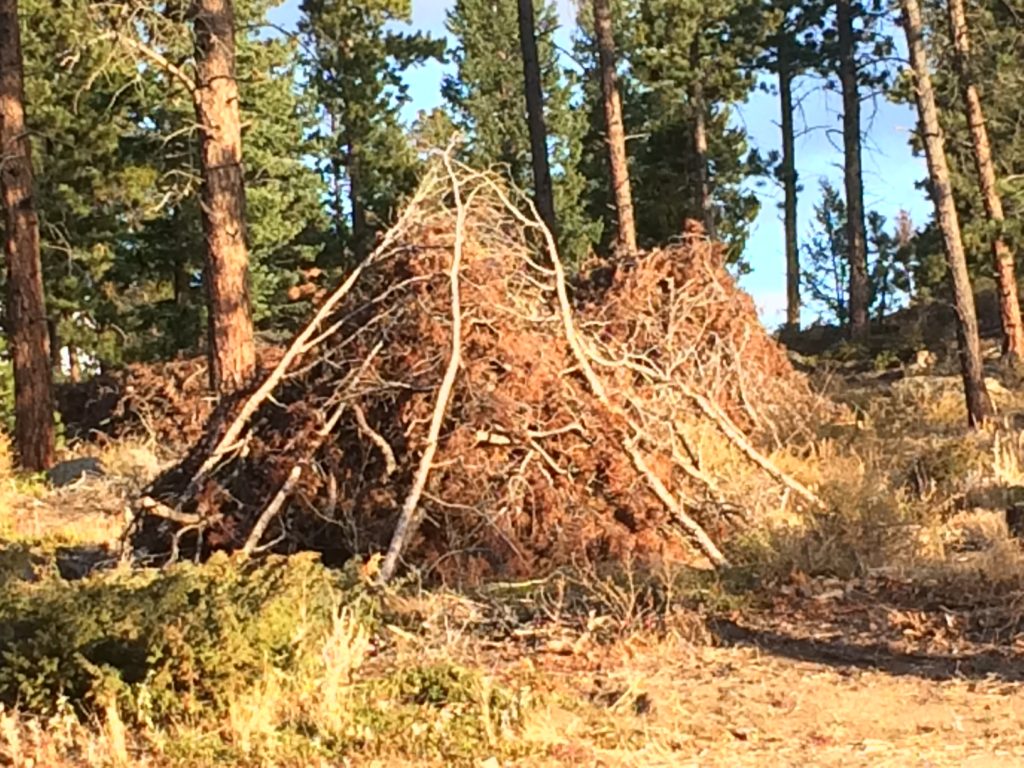 Giant haystacks. Giant haystacks of twigs, logs, needles and other assorted parts of trees. The wood haystacks line both sides of the roads. One after another, spaced somewhat evenly, some stacked higher than the other, some sprawling just a bit more. Sometimes the haystacks resemble more of a teepee, with logs tilted on their ends, the other ends meeting together in one point at the top.
Giant haystacks. Giant haystacks of twigs, logs, needles and other assorted parts of trees. The wood haystacks line both sides of the roads. One after another, spaced somewhat evenly, some stacked higher than the other, some sprawling just a bit more. Sometimes the haystacks resemble more of a teepee, with logs tilted on their ends, the other ends meeting together in one point at the top.
It’s a scene that is common throughout the mountains of Colorado. In fact, when we purchased our home in Nederland, we were confronted with these large haystacks, otherwise known as slash piles, three of them covering the land in front of our house. The seller wasn’t particularly an industrious type and had left them sitting there for many months.
Why are slash piles so common around the forests of Colorado? Well, beetle kill, disease, and wind cause lots of limbs and even entire trees to come down throughout the year. All that dead and down wood makes ample fuel for fires. Also, wildfire mitigation efforts of limbing trees (cutting the lower limbs of trees) and cutting down entire trees produces lots of logs and slash as well. So, it’s a constant battle for both property owners and Forest Service workers to collect slash into large piles.
How to get rid of the slash? Well, the quick and easy way is to burn them during winter when ample snow is on the ground, temperatures are cold and humidity is high. This is particularly effective after the the warm, windy weather has dried or “cured” the wood.
When Rocky Mountain National Park was hit particularly hard by the mountain pine beetle, they cut great numbers of dead trees down. “Hazard” trees are dead snags that are at risk to fall on road, visitors in campgrounds or picnic areas. They piled all those hazard tree logs into teepee stacks that lined Trail Ridge Road and other roads through the park. The following winter they burned these piles, burning hot and fast in the span of one day, leaving only ash circles on in the snow afterwards.
For property owners, it’s a little more complicated. Fire burning regulations and the lack of proper equipment make burning pretty much impossible. How to get rid of it? Many, many trips to the local sort yard.
It took my husband and me an entire weekend and almost 20 trips with a pickup truck to get rid of those three large slash piles. The work was laborious and exhausting. Wearing gloves and long sleeves along with jeans and grabbing piles of twigs and logs, throwing them into the back of the truck. The sort yard is a county-run facility that takes slash, and then chips into fine bits through a massive chipper.
The Forest Service slash piles have bee a source of contention with residents here in Nederland. Some of the slash piles have been sitting around for seven plus years. We hike by them and they’re still there. During the summer, they are so bone dry, should they light they would burst into flames. It’s understandable they are a sore spot with homeowners who fear wildfires like the Cold Spring wildfires.
Let’s hope some of those slash piles disappear this winter for good.

